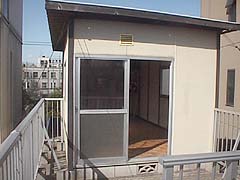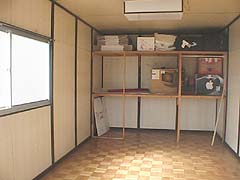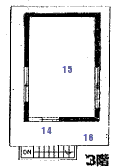
14. |
15. |
16. | |
15. The play harbour is about 10 jo. The realty agent caught me dancing in it when we came to see the house. He then felt compelled to explain that it is just a storage area (actually, he called it a lumber room, the British term). It's not heated and the light switch looks like it would electrocute the imprudent nighttime visitor. But it's a great sunny space. I'm hoping to spend time up here painting and doing other messy art projects. 16. The view is mostly rooftops, but they are nice, especially the traditional Japanese tile roof on the right. Viewed up close, you can see the strange repair methods used to keep it all together over the years--baling wire is tied around the tall ridge tiles! The neighbor opposite has her laundry out to dry. Most people don't have driers, or perhaps they prefer to hang laundry out to dry, but there is a daily flutering of shirts and other items from balconies, verandas, and outside windows all around the neighborhood. | |
 14. The play harbour
was christened when we first saw the floorplan of
the house. Pu Re Ha Bu it read in katakana, the
Japanese alphabet used for foreign words. We sounded
it out and came up with play harbour--it piqued
our curiousity--what's a play harbour? A few days
later, Tod asked one of his work collegues, who
laughed while he explained that it was not a play
harbour, but a prefab! Ah, the inadequacies of Japanese.
R is L sometimes. H is F sometimes. It's not always
easy to know when, though!
14. The play harbour
was christened when we first saw the floorplan of
the house. Pu Re Ha Bu it read in katakana, the
Japanese alphabet used for foreign words. We sounded
it out and came up with play harbour--it piqued
our curiousity--what's a play harbour? A few days
later, Tod asked one of his work collegues, who
laughed while he explained that it was not a play
harbour, but a prefab! Ah, the inadequacies of Japanese.
R is L sometimes. H is F sometimes. It's not always
easy to know when, though!